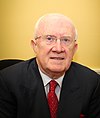User:Crylante/Sandbox/Azmara: Difference between revisions
No edit summary |
No edit summary |
||
| Line 244: | Line 244: | ||
|data-sort-value="Jonsdohter" |[[Karla Jonsdohter]] | |data-sort-value="Jonsdohter" |[[Karla Jonsdohter]] | ||
|[[Workers' Party (Azmara)|Workers']] | |[[Workers' Party (Azmara)|Workers']] | ||
|30 April 2017 – present | |||
|- | |||
|12 | |||
|Secretary of State for Transport and Communications | |||
|[[File:Official_portrait_of_Paul_Masterton_crop_2.jpg|100px]] | |||
|data-sort-value="Kryssun" |[[Karl Kryssun]] | |||
|[[Socialist Party (Azmara)|Socialist]] | |||
|30 April 2017 – present | |||
|- | |||
|13 | |||
|Secretary of State for Business and Innovation | |||
|[[File:Official_portrait_of_Antoinette_Sandbach_crop_2.jpg|100px]] | |||
|data-sort-value="Aansgaarsdohter" |[[Niina Aansgaarsdohter]] | |||
|[[Workers' Party (Azmara)|Workers']] | |||
|30 April 2017 – present | |||
|- | |||
|14 | |||
|Secretary of State for Agriculture and Rural Affairs | |||
|[[File:Official_portrait_of_David_Linden_crop_2.jpg|100px]] | |||
|data-sort-value="Jonssun" |[[Lorenc Jonssun]] | |||
|[[Workers' Party (Azmara)|Workers']] | |||
|15 January 2018 – present | |||
|- | |||
|15 | |||
|Secretary of State for Employment and Workplace Relations | |||
|[[File:Pat_the_Cope_Gallagher_(official_portrait).jpg|100px]] | |||
|data-sort-value="Jon Maarkssun" |[[Jon Maarkssun]] | |||
|[[Workers' Party (Azmara)|Workers']] | |||
|30 April 2017 – present | |||
|- | |||
|16 | |||
|Secretary of State for Culture and Equality | |||
|[[File:Official_portrait_of_Nia_Griffith_crop_2.jpg|100px]] | |||
|data-sort-value="Dunkle" |[[Nathalie Dunkle]] | |||
|[[Green Party (Azmara)|Green]] | |||
|30 April 2017 – present | |30 April 2017 – present | ||
|} | |} | ||
Revision as of 19:58, 2 August 2019
Progress Party Forþgaanenparti | |
|---|---|
| Historical leaders | Mikel Hankssun Wiljâm Jorśsun |
| Founded | 1849 |
| Dissolved | 1905 |
| Ideology | Liberalism Radicalism Laicism Republicanism Parliamentary democracy |
| Political position | Left-wing (before 1880's) Centre-left (1880's) |
1848 Revolution; Commonwealth established; liberal Forþgaaners fight conservative Jorśites for power.
-1849-1861: Forþgaaners
Universal education established.
-1861-1867: Jorśites
-1867-1873: Forþgaaners
-1873-1876: Jorśites
-1876-1888: Forþgaaners
Death penalty abolished.
-1888-1895: Jorśites
Jorśites form National Coalition.
-1895-1897: National Coalition
-1897-1900: Forþgaaners
-1900-1906: National Coalition
Rise of the labour movement; Workers' Party forms. Forþgaaners rebrand as Gold Flame.
-1906-1918: Gold Flame
FPTP abolished; emancipation of women in Fifth Amendment.
-1918-1921: National Coalition
-1921-1924: Workers'-dissident Gold Flame
New Liberals form from dissident Gold Flame.
-1924-1933: National Coalition-Gold Flame
New Liberals rename to Radicals, Azmara enters Great War on the side of Gaullica despite mass public opposition, after suspension of 1927 and 1930 elections for war effort a general strike amidst growing threat of occupation brings down the government and Azmara withdraws from the war.
-1933-1954: Workers'-Radical
Key workers' rights established, Azmara re-enters war, welfare state established, National Coalition collapses as moderates from Sotirian Democrats from its ashes.
-1954-1957: Sotirian Democrats-Gold Flame
-1957-1960: Workers'-Radical
-1960-1963: Sotirian Democrats-Gold Flame
-1963-1966: Workers'-Radical
Abortion decriminalised.
-1966-1969: Gold Flame-Sotirian Democrats
-1969-1975: Radical-Sotirian Democrats
-1975-1978: Workers'-Radical
-1978-1987: Gold Flame-Sotirian Democrats
Neoliberalism is in power. A programme of deregulation and privatisation is pursued. Workers' Party support sinks to low levels.
-1987-1993: Gold Flame-Radical
Civil unions for same-sex couples introduced: neoliberalism continues.
-1993-1999: Workers' Party-Radical
The Workers' Party pursues a new centrist outlook: Socialist Party splits in protest, Green Party grows in support.
-1999-2005: Workers' Party-Gold Flame
The Grand Coalition comes to power; same-sex marriage legalised, multiculturalism encouraged, soft drugs decriminalised.
-2005-2008: Sotirian Democrats-Radical-Green
A centrist coalition comes to force against the growing threat of the right-wing People's Party. Status quo is largely maintained.
-2008-2011: Workers' Party-Radical-Sotirian Democrats-Green
A centre-left government is established, but little is achieved due to disagreements between parties.
-2011-2014: Gold Flame-Sotirian Democrats w/ People's support
Controversially, the support of the right-wing People's Party is used to form a government. Restrictions on immigration increased. New single issue parties such as Free Alliance and the Grey Party form.
-2014-2017: Gold Flame-Sotirian Democrats-Radical
The Radical Party agrees to support the government on the condition that the anti-immigration policies passed under the last government are repealed. New Azmara forms before election.
-2017-present: Workers'-Green-Socialist-New Azmara
A new left-wing government comes to power in Azmara in opposition to neoliberalism and Third Way politics. Eryk Bogskuuta becomes Prime Minister.
| Party logo | Party name | Leader | Folksmot seats | Landsmot seats | Provincial Presidents | Euclean Parliament seats |
Ideology | |
|---|---|---|---|---|---|---|---|---|
| Workers' Party Arbeiderpartii |
 Eryk Jorśsun |
56 / 150
|
18 / 75
|
3 / 8
|
8 / 22
|
|||
| The Workers' Party was formed in 1902 as a coalition of Azmaran trade unionists and socialists in order to give a voice to the industrial working classes. It soon became a major force in Azmaran politics, forming a coalition government with rebels from Gold Flame in 1921 and later forming the government for 21 consecutive years between 1933 and 1954. Later it would alternate in power with centre-right coalitions, yet between 1981 and 1993 was out of power for 12 years before returning under a more centrist course. It would then form a government between 2008 and 2011 and in 2017 re-entered government under a more left-wing stance under Eryk Jorśsun. | ||||||||
| Gold Flame Gyldflam |
 Freidrik Aleksanderssun |
24 / 150
|
14 / 75
|
2 / 8
|
4 / 22
|
|||
| Gold Flame was formed by the bulk of the liberal Forþgaaner faction in the run up to the 1903 election as the party moved to a more centrist stance to combat the rise of socialism. The party became the government in 1906, introducing women's suffrage and proportional representation. The party later formed a government with the National Coalition in 1924, which controversially brought Azmara into the Great War on the Entente side yet was bought down in 1932 by a general strike. Repositioning itself in the centre after the war, it eventually moved to a more right-wing stance in the 1980's, implementing a series of neoliberal reforms in an attempt to stimulate the economy and cemented itself as the main centre-right party in Azmara, being in government between 1999 and 2005 and between 2011 and 2017. | ||||||||

|
Sotirian Democrats Sortiren Folksrâgelen |
 Aansgaar Jonsun |
22 / 150
|
16 / 75
|
2 / 8
|
3 / 22
|
||
| The Sotirian Democrats were founded in 1937 by the moderate wing of the former National Coalition party in an attempt to form a new conservative force in Azmaran politics after the collapse of the latter in the 1933 election. The party would first enter government in 1954 in a coalition with Gold Flame, committing itself to the newly-created welfare state while maintaining support for traditional values. The party was very influential between 1960 and 1987, being in government for 15 out of 27 years, and would remain in government between 2005 and 2017 under various coalitions. It is currently in opposition. | ||||||||
| The Radicals Radikaalen |
 Ana Freidriksdohter |
13 / 150
|
10 / 75
|
1 / 8
|
3 / 22
|
|||
| The Radicals were formed in 1922 as the New Liberal Party from a group of left-liberal members of the Folksmot who broke away from Gold Flame to support the Workers' Party in government. It rebranded to the Radicals in 1924 and became known as a strong critic of Azmaran involvement in the Entente. It formed a government with the Workers' Party after the 1933 election and the 1932 General Strike, and has often governed in coalition with the Workers' Party, yet has also been in coalition with the Sotirian Democrats and Gold Flame, even going so far as to lead the government between 1969 and 1975. The party is known for being a strong supporter of feminism, LGBT rights, environmentalism and federalism. | ||||||||
| File:Green Party.png | Green Party Groonpartii |
 Aleksander Erykssun |
9 / 150
|
6 / 75
|
0 / 8
|
2 / 22
|
||
| The Green Party was formed in 1985 by environmentalist, socially progressive and anti-nationalist student protest groups as a vehicle to bring attention to these issues. It entered the Folksmot in the 1993 election, gaining three seats. It would contest the 1996 and 1999 elections on a joint list with the Socialist Party, which established both parties as major forces on the national stage. The party would enter a coalition with the Workers' Party, the Radicals and the Sotirian Democrats in 2008 under Niina Hermansdohter, which would remain in place until the party withdrew in 2011 citing its opposition to austerity. It re-entered government in 2017 in coalition with the Workers' Party and the Socialist Party, with party veteran Liis Jonsdohter being made Deputy Prime Minister and Foreign Secretary. Her resignation in 2018 led to her replacement by Aleksander Erykssun, the party's long term leader. | ||||||||
| People's Party Folkspartii |
 Hank Hankssun |
8 / 150
|
2 / 75
|
0 / 8
|
1 / 22
|
|||
| The People's Party was founded in 2002 by the merger of the pan-Weranicist Destiny Party, the agrarian Centre Party and the Euclosceptic Direct Democrats into a new force against increased Euclean integration. The party soon won its first seats in the Euclean Parliament, yet failed to carry this success to the 2005 general election. However, as the Euclean Recession hit, the party saw a mass uptick in popular support and under the leadership of Hank Hankssun diversified its platform to include opposition to immigration, especially from Irfanic nations, combining this with economic populism and cultural liberalism. This approach paid off, with the party getting 15 seats in 2008 and 16 seats in 2011. It backed up a coalition of Gold Flame and the Sotirian Democrats after 2011, which caused the party to lose support and it eventually withdrew support, triggering the 2014 election, in which the party suffered. | ||||||||
| Protocol order | Office | Image | Incumbent | Party | In office |
|---|---|---|---|---|---|
| 1 | Prime Minister of Azmara | 
|
Eryk Jorśsun | Workers' | 30 April 2017 – present |
| 2 | Deputy Prime Minister of Azmara Secretary of State for Foreign Affairs |

|
Aleksander Erykssun | Green | 25 June 2018 – present |
| 3 | Secretary of State for Finance and Economic Affairs | 
|
Helmut Mâþijassun | Workers' | 30 April 2017 – present |
| 4 | Secretary of State for Internal Affairs | 
|
Sofija Anasdohter | Workers' | 30 April 2017 – present |
| 5 | Secretary of State for Defence | 
|
Mâþis Aleksanderssun | Workers' | 14 March 2018 – present |
| 6 | Secretary of State for Education and Research | 
|
Jorśena Hanksdohter | Workers' | 30 April 2017 – present |
| 7 | Secretary of State for Healthcare | 
|
Mâþijas Jonssun | Workers' | 21 January 2019 – present |
| 8 | Secretary of State for Justice Attorney-General |

|
Jana Eryksdohter | Independent | 23 June 2004 – present |
| 9 | Secretary of State for Energy, Climate Change and Environmental Affairs | 
|
Isabela Krysdohter | Green | 30 April 2017 – present |
| 10 | Secretary of State for Pensions and Social Welfare | 
|
Maarijana Karlsdohter | Socialist | 30 April 2017 – present |
| 11 | Secretary of State for Euclean Affairs | 
|
Karla Jonsdohter | Workers' | 30 April 2017 – present |
| 12 | Secretary of State for Transport and Communications | 
|
Karl Kryssun | Socialist | 30 April 2017 – present |
| 13 | Secretary of State for Business and Innovation | 
|
Niina Aansgaarsdohter | Workers' | 30 April 2017 – present |
| 14 | Secretary of State for Agriculture and Rural Affairs | 
|
Lorenc Jonssun | Workers' | 15 January 2018 – present |
| 15 | Secretary of State for Employment and Workplace Relations | 
|
Jon Maarkssun | Workers' | 30 April 2017 – present |
| 16 | Secretary of State for Culture and Equality | 
|
Nathalie Dunkle | Green | 30 April 2017 – present |